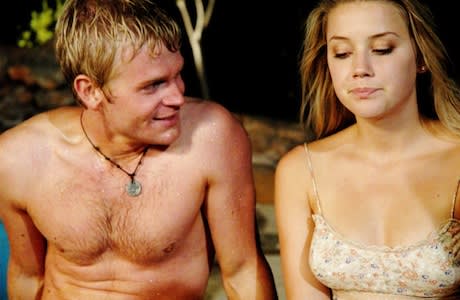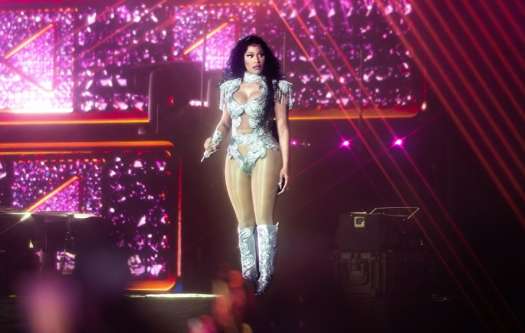Back in 2006, All the Boys Love Mandy Lane did the festival circuit, receiving primarily underground, blogger acclaim for its superficial pseudo-academic take on standardized horror tropes, reiterating the blasé nostalgic aesthetic of throwaway '70s trash while deliberately subverting genre conventions. At the time, this sort of self-awareness tinged with despondence and existential angst (Mandy Lane is more depressing than it is scary) stood out by criticizing the very sensationalism and desensitized indulgence it promised without making referential comedy out of its own deconstructionism.
Now that the rights have been reacquired by the Weinstein's (they sold them to Senator Entertainment after Grindhouse proved to have little appeal to those not reconciling or performing their insecurities on the Internet) and Mandy Lane is receiving a relatively proper release, it has a somewhat different, less relevant, context.
In setup, this play on how sexuality and morality is portrayed in horror presents as standard-issue slasher. Shy high school student Mandy Lane (Amber Heard) is invited to a pool party with the cool kids, having developed desirable "assets" (featured in close-up during the opening scene) over the summer. She invites her geeky best friend Emmet (Michael Welch) despite his not being overly welcome, which inevitably results in a bout of machismo male bullshit and nonsense teen posturing culminating in a passive-aggressive dare that leaves an alpha male douche jumping off the roof into the pool, smacking his head off the bottom and promptly dying. Everyone blames Emmet and the movie jumps ahead in time to an impromptu teen vacation at a remote cottage with Mandy and an interchangeable gang of shallow teen assholes that spend their time snorting drugs, insulting each other's body types and occasionally engaging in handjobs and fellatio. And, as the title suggests, Mandy is the virginal type that all the boys want.
Presumably, the performative, exaggerative abject morality demonstrated by these intentionally vile ciphers would lead to a series of ironic killings (one girl meets her fate with a shotgun rammed down her throat shortly after sucking what has been identified as the smallest dick in the house), leaving Mandy Lane—a paradigm of chastity and virtue—to defeat the oppressor. It's also assumed that Emmet—who is absent from the party—is the one lurking outside, killing off every drunk and stoned teen that wanders off to start a generator or skinny dip.
In a modern context, the eventual rejection of familiar genre tropes is actually more predictable than if Mandy Lane really were to wax Jamie Lee Curtis by the end of the film. In 2006, though audiences were still conscious of the formula and the smugness associated with filmmakers self-consciously exploiting it, the twist still packed a bit of a punch. And since gritty, visceral, essentially nihilistic, rubbish like Saw was relatively fresh within the cultural lexicon, horror as a defeatist reflection of a society gravitating towards a more superficial, conservative ethos held some intrigue.
Now, the idea of Mandy Lane as a deliberately vague, passive vessel, blindly desired without effort to interpret or understand what she might represent or embody, is still a playful conceit that questions the dominant gaze. But the generalized outcome and structure of this depressive take on regressive teen trash like Cabin Fever is almost a redundancy in 2013. Since the tells throughout Mandy Lane are so obvious now that the disruption of expectation is ubiquitous in genre cinema, it leaves the outcome rote and predictable, limited in an analytical capacity. This leaves only the idea of desire—something theorized endlessly by people like Carol Clover long before this movie was made—to hold any interest beyond the shots of pointless nudity and casually impassive deaths.
(eOne)Now that the rights have been reacquired by the Weinstein's (they sold them to Senator Entertainment after Grindhouse proved to have little appeal to those not reconciling or performing their insecurities on the Internet) and Mandy Lane is receiving a relatively proper release, it has a somewhat different, less relevant, context.
In setup, this play on how sexuality and morality is portrayed in horror presents as standard-issue slasher. Shy high school student Mandy Lane (Amber Heard) is invited to a pool party with the cool kids, having developed desirable "assets" (featured in close-up during the opening scene) over the summer. She invites her geeky best friend Emmet (Michael Welch) despite his not being overly welcome, which inevitably results in a bout of machismo male bullshit and nonsense teen posturing culminating in a passive-aggressive dare that leaves an alpha male douche jumping off the roof into the pool, smacking his head off the bottom and promptly dying. Everyone blames Emmet and the movie jumps ahead in time to an impromptu teen vacation at a remote cottage with Mandy and an interchangeable gang of shallow teen assholes that spend their time snorting drugs, insulting each other's body types and occasionally engaging in handjobs and fellatio. And, as the title suggests, Mandy is the virginal type that all the boys want.
Presumably, the performative, exaggerative abject morality demonstrated by these intentionally vile ciphers would lead to a series of ironic killings (one girl meets her fate with a shotgun rammed down her throat shortly after sucking what has been identified as the smallest dick in the house), leaving Mandy Lane—a paradigm of chastity and virtue—to defeat the oppressor. It's also assumed that Emmet—who is absent from the party—is the one lurking outside, killing off every drunk and stoned teen that wanders off to start a generator or skinny dip.
In a modern context, the eventual rejection of familiar genre tropes is actually more predictable than if Mandy Lane really were to wax Jamie Lee Curtis by the end of the film. In 2006, though audiences were still conscious of the formula and the smugness associated with filmmakers self-consciously exploiting it, the twist still packed a bit of a punch. And since gritty, visceral, essentially nihilistic, rubbish like Saw was relatively fresh within the cultural lexicon, horror as a defeatist reflection of a society gravitating towards a more superficial, conservative ethos held some intrigue.
Now, the idea of Mandy Lane as a deliberately vague, passive vessel, blindly desired without effort to interpret or understand what she might represent or embody, is still a playful conceit that questions the dominant gaze. But the generalized outcome and structure of this depressive take on regressive teen trash like Cabin Fever is almost a redundancy in 2013. Since the tells throughout Mandy Lane are so obvious now that the disruption of expectation is ubiquitous in genre cinema, it leaves the outcome rote and predictable, limited in an analytical capacity. This leaves only the idea of desire—something theorized endlessly by people like Carol Clover long before this movie was made—to hold any interest beyond the shots of pointless nudity and casually impassive deaths.




